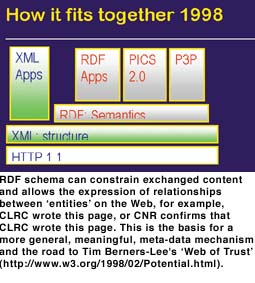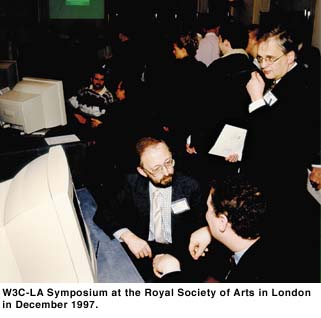The World Wide Web Working Group - W4G
by Stuart K Robinson
The World Wide Web Consortium, W3C, an industry consortium of over 350 organisations, jointly run at the W3C hosts MIT (USA), INRIA (Europe) and Keio University (Asia), was created to enhance the interoperability and promote the evolution of the World Wide Web. ‘Leveraging Actions for Software Technologies’, sponsored by the Europeam Esprit programme, were aimed at accelerating the wide adoption of innovative software technologies by European industrial, financial and commercial users. On 24 November 1997 W3C announced the launch of W3C-LA (Leveraging Action), a joint project between INRIA and CLRC-RAL to leverage the Web for European industry. By the end of the project in 1999, European membership of W3C had increased by 38%, faster than in the USA over the same period.
The core developments of the W3C improve the basic functionality of the Web, increasing its expressive power and its flexibility. During the lifetime of W3C-LA, the Web has undergone fundamental change, going from a system concerned with the world-wide exchange of a particular form of document (expressed by HTML 4.0) to one based around:
• the separation of content from presentation with the introduction of the concept of style sheets, (CSS, http://www.w3.org/Style/), which the association of style with tags
• the exchange of user-defined structured data (XML, http://www.w3.org/XML/), a special case of which are documents, a special case of which are HTML 4.0 documents.
The Extensible Markup Language (XML) uses the concept of an optional description (a Document Type Definition - DTD) defining the structure of the data and exchanges data marked up using the tagging declared by that DTD. For the particular case of HTML documents, a DTD - XHTML (http://www.w3.org/MarkUp/) is currently under development.Further DTDs are under development, for example
• for mathematics (MathML - http://www.w3.org/Math/)
•synchronised multi-media (SMIL - http://www.w3.org/AudioVideo/)
• chemistry (CML)
• schematic graphics (SVG - http://www.w3.org/Graphics/SVG/).
The shift to XML, allows ‘documents’ to be exchanged that are compositions of several tagged components from differing DTDs, as all structured data is expressed in the same format.For example, a document can have text using XHTML, with sections using mathematical notation (MathML) embedded within a schematic graphic, all within one uniform framework (one syntax, one parser).
Style sheets (now XSL, http://www.w3.org/Style/XSL/ with enhanced tag identi-fication) can be applied uniformly to any DTD. Additionally, an API to the abstract syntax of the document has been defined (Document Object Model, DOM http://www.w3.org/DOM/), which, coupled with scripting, allows portable, interactive, client-side processing of the transmitted data, reducing server load and Internet traffic.

XML not only provides the basis for user defined data exchange, but additionally provides the framework for the exchange of Web infrastructure data, such as meta-data (http://www.w3.org/Metadata/). Previously, a whole series of unrelated syntaxes and semantics were being developed, resulting in ‘browser bloat’ and a heavyweight HTML. Such infrastructure mechanisms, for example content selection (http://www.w3.org/PICS/) and privacy preferences (http://www.w3.org/P3P/), can become particular XML applications. In particular, the introduction of the Resource Description Framework (RDF, http://www.w3.org/RDF/) allows the exchange of semantics over the Web as just another XML application. The Resource Description Framework (RDF) integrates a variety of web-based metadata activities including sitemaps, content ratings, stream channel definitions, search engine data collection (web crawling), digital library collections, and distributed authoring.
With this infrastructure in place, and with the energy of commercial interest in digital television (http://www.w3.org/TV/), the integration of the Web and television is rapidly approaching. Different standardisation bodies and vendors will make significant efforts over the next year to achieve this, thus enabling applications such as browsing the Web using a television set, or using Web content formats to annotate a television broadcast, making television more interactive. With these innovations, the whole fabric of society changes – entertainment, the democratic process, business and the workplace.
W3C-Leveraging Action
W3C-LA developed awareness of the W3C and these recent changes, and encouraged industry champions to demonstrate their positive impact on future business. Key initiatives were developed to characterise the business drivers for and the impediments to the uptake of the Web’s maturing technology opportunities. The W3C Office initiative, established through W3C-LA, resulted in six European W3C local offices being opened at ERCIM institutions. Later sections below detail the activities of the first and last Offices to open during W3C-LA
W3C Offices
To enhance the communication between W3C and the Web community, W3C-LA opened six European W3C national Offices (RAL, GMD, SICS, FORTH, CWI, CNR) as the first point of contact between the Consortium and local W3C members, and also the general public, with an ongoing responsibility to organise local events.
Symposia and Workshops
To encourage organisations to start to use the Web as a ubiquitous medium, meetings were held across Europe. The pattern established by CLRC and followed by the other Offices was an initial " management level introduction to W3C, followed by technical workshops and a specific hands-on workshops and finally an industrial champions' day. Additionally a large number of other talks and presentations were given throughout Europe, a monthly Newsletter established and a W3C Office Press Releases distributed.
To exhibit innovative uses of the W3C developments, shrink-wrapped demonstration packages were developed and disseminated throughout Europe at W3C-LA or related events. The demonstrations gradually used more of the results from the W3C-LA technical work-packages as the project progressed and included: HTTP 1.1 Performance, PICS, CSS Validator, MathML and XML, PNG, Scalable Vector Graphics, SMIL, Amaya, RDF and Workflow, XML/XSL and Hyperglossaries and CGM Web Profile.
The Web community uses the Web itself as the primary medium for communication. W3C is no exception. W3C-LA enhanced European access to W3C information by beginning to mirror the INRIA site at the Offices via satellite. This also allowed the establishment of African Offices in Morocco and Tunisia.
The W3C-Office at Rutherford Appleton Laboratory
The RSA Symposium: Visions of the Web The first office to open was that at RAL. Activities began with a high-profile W3C-LA Symposium at the Royal Society of Arts in London in December 1997 organised jointly by Computer Weekly, DISC and RAL. Some 150 senior executives from leading UK companies heard W3C Chairman Jean-François Abramatic open the proceedings by describing the Web as a people-to-people communication medium, a machine-to-people framework for computing knowledge and a machine-to-machine information infrastructure. He was followed by star attraction Tim Berners-Lee, inventor of the Web, and W3C Director, who described his dream of a hypertext system which would be ‘personally cool’, enable social efficiency and understanding and allow the exploitation of computing power in real life. His vision was for the Web to become a single universal space encompassing PCs to TVs, hypertext, video on demand and RT channels and spanning the personal to the global, the scribbled to the polished. Getting somewhat carried away he even coined a new word ‘intercreativity’ meaning building things together in the Web. He went on to talk of the importance of the "Web of Trust", the whole security infrastructure from keys and signed documents to personal information, which will allow electronic commerce to take place safely and securely. The afternoon was devoted to the explanation of the work of the W3C covering the User Interface, Architecture, and Technology and Society Domains. These talks were complemented throughout the day by demonstrations that illustrated many of these new developments and how they could impact the Web in the future.

Following the success of the RSA event, the office published a UK W3C monthly newsletter highlighting a current topic, and tracking membership trends and Web related events. Some 800 organisations asked to receive it and future information about the W3C. The Newsletter was made available to the other European Offices, and is available throughout Europe via the local Offices.
Further ‘Open Symposia’ describing the recent Web advances took place as further offices opened at SICS, GMD, CWI (March/April 1998), and a tutorial event was held at FORTH in September 1998. These were followed by "Demonstrator Advice Workshops" aimed at potential industrial champions (users of W3C recommendations and W3C-LA demonstrators). The purpose was to explain to potential users the technologies behind the demonstrators, thereby encouraging their take-up. A Technical Workshop, with RAL experts detailing various innovations, was held at RAL on 17th July 1998 and a hands-on SMIL (the most developed demonstrator) workshop, also at RAL.
The Office has its own Web site and all existing (and Future) Newsletters and the slides from many of the events are available through that site. Additionally the RAL W3C Mirror site began operation in February 1999. For more information on the RAL W3C Office see http://www.w3c.rl.ac.uk
A second RSA event was run in December 1998 where industrial champions presented use that they were making of the emerging technologies from thereby encouraging its take-up by other users. Jon Bosak of Sun give an excellent talk on XML, highlighting the effect of the XML linking proposals, illustrated by showing the work of a Californian company with its copy in XML and using XSL to style it in different newspaper styles. Chris Lilley of the W3C gave an overview of the SVG activity. Tony Stuart of RivCom gave an entertaining talk on how RivCom are using XML to specify industrial data on a range of projects. Lynn Labieniec from RivCom were also demonstrators along with staff from RAL, INRIA and VHL. Much had already changed in one year!
The W3C-Office at CNR
The Italian W3C Office (e.mail: w3c-cnr@cnr.it) organised its opening event on April 22nd 1999, in Pisa, hosted by CNR. The event was a success, with more than 130 participants and presentations offered by the W3C team. The event also hosted a round table, where convenors expressed their views about the opportunities of Internet applications, and the related difficulties. It was stressed that the use of the Internet by the public at large in Italy is not as widespread as in other countries, but the general feeling was that the size of the market would grow rapidly. From this perspective, the interest showed by the Italian Government in the Information Society appears to emphasise the growth of the use of this technology.
The Ministry of Industry participated in the event and declared that they were very interested in supporting the Office initiative and its activities. As a consequence of the opening event, a web site (http://w3c.cnr.it) and a discussion list (w3c-it@cnr.it) have been set up. Details about the event, and full coverage of sessions are available in real video on the site.
After the opening, the Italian W3C Office immediately started to work with the Italian W3C members. A plenary session has already been held and more will be held on a monthly basis. The Italian members appreciate this approach as it allows them be more in contact with the Consortium than merely being present at international events. The Italian Press has already showed high interest in the Office's activities. Many Italian newspapers have already covered Office activities and a more constant and official presence is being planned. After these first months of existence the Office is planning its activities for the near future. First of all a schedule of events for various target audiences will be released in September. The writing of documentation, illustrating the advantages of becoming a W3C member will be the first step in a recruitment campaign.
Links:
W3C: http://www.w3.org/
W3C-LA: http://www.w3.org/W3C-LA/.
Please contact:
Stuart K Robinson - CLRC
Tel: +44 1235 44 5119
E-mail: S.K.Robinson@rl.ac.uk
